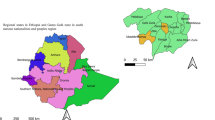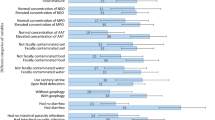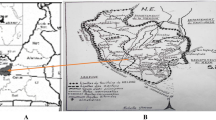Abstract
Objective: To evaluate the relationship between stunting, Schistosoma mansoni infection and dietary intake in schoolchildren.
Design: This is a cross-sectional study. Two stool samples were obtained from each child and examined quantitatively for the presence of S. mansoni, Ascaris lumbricoides and Trichuris trichiuria eggs. Information on dietary intake, and demographic, biologic and socioeconomic variables was elicited during the in-home survey. Logistic regression was used to evaluate the association between stunting (height for age <−2s.d.), parasitic infection and food consumption.
Setting: The study was carried out in the city of Nazaré, located in the Recôncavo region of the State of Bahia, northeastern Brazil.
Subjects: The sample consisted of 461 children 7–14 y old, 228 boys and 233 girls, recruited from public schools.
Results: Of the children studied, 55.1% presented with S. mansoni infection and 22.1% were stunted. The median protein, lipid and carbohydrates intake were 47.8, 36.0 and 248.2 g/day, respectively. The median caloric consumption was 1527.0 kcal (6388.97 kJ/day). The analysis indicated that children heavily infected (≥400 eggs/g of stool) with S. mansoni had a 2.74-fold (95% CI: 1.32–5.67) higher risk of stunting than uninfected children, and those with inadequate intake of lipid (<36 g/day) had a 1.83-fold (95% CI: 1.05–3.20) increased risk of stunting compared to those with adequate diets.
Conclusion: Heavy S. mansoni infection and inadequate dietary intake of fat in schoolchildren play a significant and independent role in the development of stunting. This meaning that nutritional interventions in this age group in S. mansoni endemic areas must include the diagnosis and treatment of the infection associated with dietary measures.
Sponsorship: This study was supported by the Thrasher Foundation. Sandra Maria Conceição Pinheiro is a National Council on Technological Development Scholarship Awardee (CNPq), #302228/81-0.
This is a preview of subscription content, access via your institution
Access options
Subscribe to this journal
Receive 12 print issues and online access
$259.00 per year
only $21.58 per issue
Buy this article
- Purchase on Springer Link
- Instant access to full article PDF
Prices may be subject to local taxes which are calculated during checkout
Similar content being viewed by others
References
Administrative Committee on Coordination/Sub Committee on Nutrition News — United Nations (ACC/SCN) (1997): Third Report on the World Nutrition Situation. Geneva: ACC/SCN.
Administrative Committee on Coordination/Sub Committee on Nutrition News — United Nations (ACC/SCN) (2000): Nutrition through out the life cycle Fourth Report on the World Nutrition Situation Geneva: ACC/SCN.
Allen LH (1994): Nutritional influences on linear growth: a general review. Eur. J. Clin. Nutr. 48 (Suppl 1), S75–S89.
Allen LH & Gillespie SR (2001): What works? A review of efficacy and effectiveness of nutrition interventions Administrative Committee on Coordination/Sub Committee on Nutrition (ACC/SCN) Geneva in collaboration with the Asian Development Bank.
Ancao MS, Cuppari L, Tudisco ES, Draibe AS & Sigulem D (1996): Sistema de apoio à Decisão em nutrição versão 2.5 Centro de Informática em Saúde, Escola Paulista de Medicina, São Paulo.
Andrade RG, Pereira RA & Sichieri R (2003): Food intake in overweight and normal-weight adolescents in the city of Rio de Janeiro. Cad. Saude Publica. 19, 1485–1495.
Araújo MPN, Martins MC, Prado MS, Assis AMO & Santos LMP (1993): Dimensionamento de medidas caseiras, Salvador Relatório Técnico. Departamento das Ciências da Nutrição, Escola de Nutrição da Universidade Federal da Bahia, Bahia-Brasil.
Assis AMO, Barreto ML, Prado MS, Reis MG, Parraga IM & Blanton R (1998): Schistosoma mansoni infection and nutritional status in schoolchildren: a randomized, double-blind trial in northeastern Brazil. Am. J. Clin. Nutr. 68, 1247–1253.
Assis AMO, Monteiro MC, Santana MLP & Santos NS (2002a): Diagnóstico de saúde e nutrição da população de Mutuípe-Ba Publicação da Serie UFBa em Campo. Universidade Federal da Bahia (in portuguese).
Assis AMO, Monteiro MC, Santana NLP & Pinheiro SMC (2002b): Condições de saúde e nutrição de adolescentes, adultos e idosos da cidade de Salvador Relatório Técnico. Centro Colaborador Nordeste II/Ministério da Saúde (in portuguese).
Bina JC & Prata A (2003): Esquistossomose na área hiperendêmica de Taquarendi I—Infecção pelo Schistosoma mansoni e formas graves. Rev. Soc. Bras. Med. Trop. 36, 211–216.
Caulfied LE, Himes JH & Rivera JA (1995): Nutritional supplementation during early childhood and bone mineralization during adolescence. J. Nutr. 125, 1104S–1111S.
Corbett EL, Butterwort AE, Fulford AJ, Ouma JH & Sturrock RF (1992): Nutritional status of children with schistosomiasis mansoni in two different areas of Machakos District, Kenya. Trans. R. Soc. Trop. Med. Hyg. 86, 266–273.
Coutinho EM, Abath FGC, Barbosa CS, Domingues ALC, Melo MCV, Montenegro SML, Lucena MAF, Romani SAM, Souza WV & Coutinho AD (1997): Factors involved in Schistosoma mansoni infection in rural areas of Northeast Brazil. Men. Inst. Oswaldo Cruz. 92, 707–715.
de Onis M, Frongillo EA & Blossner M (2000): Is malnutrition declining? An analysis of changes in levels of child malnutrition since 1980. Bull World Health Organ. 78, 1222–1233.
de Silva (2003): Impact of mass chemotherapy on the morbidity due to soil-transmitted nematodes. Acta Trop. 86, 197–214.
Dickson R, Awasthi S, Williamson P, Dmellweek C & Garner P (2000): Effects of treatment helminth infection on growth and cognitive performance in children: systematic review of randomized trials. BJM 320, 1697–1701.
Duarte EC, Scchneider MC, Paes-Souza R, Ramalho WM, Sardinha LMV, Silva Júnior JB & Castillo-Salgado C (2002): Epidemiologia das desigualdades em saúde no Brasil. Um estudo exploratório. FUNASA/OPAS/OMS: http://www.funasa.gov.Br/pub/epi_desigualdades/epi_desigualdades.pdf Acess in 22/07/03.
Ferreira HS & Coutinho EM (1999): Should nutrition be considered as supplementary measure in schistosomiasis control? Ann. Trop. Med. Parasitol. 93, 437–447.
Fisher EA, Van Horn L, Henry C & McGill HJ (1997): Nutrition and children: a statement for healthcare professionals from the nutrition committee. Circulat. 95, 2332–2333.
Friis H, Ndhlovu P, Kaondera K, Sandström B, Michaelsen KF & Vennervald BJ (1996): Serum concentration of micronutrients in relation to schistosomiasis and indicators of infection: a cross-sectional study among rural Zimbabwean schoolchildren. Eur. J. Clin. Nutr. 50, 386–391.
Fulford AJC, Webster M, Ouma JH, Kimani G & Dunne DW (1998): Puberty age-related changes in susceptibility to schistosome infection. Parasitol. Today 14, 23–26.
Hosmer DW & Lemeshow S (1989): Applied Logistic Regression. New York: Wiley.
Katz N (1998): Schistosomiasis control in Brazil. Mem. Inst. Oswaldo Cruz 93, 33–35.
Katz N & Pellegrino JS (1972): Title: Simple device for quantitative determinations of S. mansoni eggs in faeces examined by the thick-smear technique. Rev. Inst. Med. Trop. 14, 397–400.
Lima e Costa MFF, Leite MLC, Rocha RS, Magalhães MHA & Katz N (1988): Anthropemetric measures in relation to schistosomiasis mansoni and socioeconomic variables. Int. J. Epidemiol. 17, 880–886.
Lin BH, Guthrie J & Frazao E (2001): American childrens diets not making the grade: examining the well-being of children. Food Rev. 24, 8–17.
McGarvey ST, Wu G, Zhang S, Wang Y, Peters P, Olds R & Wiest P (1993): Child growth, nutritional status, and schistosomiasis japonica in Jiangxi, people's Republic of China. Am. J. Trop. Med. Hyg. 48, 547–553.
Monteiro CA (Organizador) (1995): Velhos e novos males da saúde no Brasil Editora Hucitec/NUPENS/USP (in portuguese).
Nilson A, Ohlsson C, Isaksson OGP, Lindahl A & Isgaard J (1993) Hormonal regulation of longitudinal bone growth: http://www.unu.edu/unupress/food2/UID06E/uid06e0y.htm 04/08/03.
Northrop-Clews CA, Rousham EK, Mascie-Taylor CGN & Lunn PG (2001): Anthelmintic treatment of rural Bangladeschi children: effect on host physiology, growth, and biochemical status. Am. J. Clin. Nutr. 73, 53–60.
Oberhelman RA, Guerrero ES, Fernández ML, Silio M, Mercado D, Comiskey N, Ihenacho G & Mera R (1998): Correlations between intestinal parasitosis, physical growth and psychomotor development among infants and children from rural Nicaragua. Am. J. Trop. Med. Hyg. 58, 470–475.
Parraga IM, Assis AMO, Prado MS, Barreto ML, Reis MG, King CH & Blanton RE (1996): Gender differences in growth of schoolaged children with schistosomiasis. Am. J. Trop. Med. Hyg. 55, 150–156.
Proietti FA, Paulino UH, Chiari CA, Proietti AB & Antunes CM (1992): Epidemiology of Schistosoma mansoni infection in a low-endemic area in Brazil: clinical and nutritional characteristics. Rev. Inst. Med. Trop. São Paulo. 34, 409–419.
Remer T & Manz F (1999): Role of nutritional status in the regulation of adrenarche. J. Clin. Endocrinol. Metab. 84, 3936–3944.
Ross AGP, Bartlet PB, Sleigh AC, Adrian C, Olds GR, Li Y, Williams GM & McManus DP (2002): Current concepts: schistosomiasis. New Engl. J. Med. 346, 1212–1220.
SAS (1999–2000): System for Windows V8. Cary, USA: SAS Institute Inc Misc.
Seidell JC (1998): Dietary fat and obesity: an epidemiologic perspective. Am. J. Clin. Nutr. 67 (Suppl 3), S546–S550.
Sichieri R & Allam VL (1996): Assessment of the nutritional status of Brazilian adolescents by body mass index. J. Pediatr. 72, 80–84.
Stephensen CB (1999): Burden of infection on growth failure. J. Nutr. 129 (Suppl 2), S534–S538.
Stephenson L (1993): The impact of schistosomiasis on human nutrition. Parasitology 107, S107–S123.
Stephenson LS, Latham MC, Kurz KM & Kinoti S (1989): Single dose metrifonate or praziquantel treatment in Kenyan children: II. Effects on growth in relation to Schistosoma haematobium and Hookworm egg counts. Am. J. Trop. Med. Hyg. 41, 445–453.
Stephenson LS, Latham MC, Adms EJ, Kinoti SN & Pertet A (1993): Physical fitness, growth and appetite of Kenyan school boys with hookworm, Trichuris trichiura and Ascaris lumbricoides infections are improved four months after a single dose of albendazole. J. Nutr. 123, 1036–1046.
Sukwa TY, Bulsara MK & Wurapa F (1986): The relationship between morbidity and intensity of Schistosoma mansoni infection in a rural Zambian community. Int. J. Epidemiol. 15, 128–251.
Tomkins A & Watson F (1989): Malnutrition and infection Nutrition policy discussion papers no. 5, ACC/SCN.
Waterlow JC (1994): Summary of causes and mechanisms of linear growth retardation. Eur. J. Clin. Nutr. 48 (Suppl 1), S210–S211.
Willett W (1990): Nutritional Epidemiology. New York: Oxford University Press.
World Health Organization (1995): Physical status: the use and interpretation of anthropometry WHO Technical Report Series 854 Geneva: WHO.
World Health Organization (1998): Guidelines for the evaluation of soil-transmitted helminthiasis and schistosomiasis at community level Document WHO/CTD/SIP/98.1. Geneva: WHO.
World Health Organization (1999a): Report of the WHO informal consultation on schistosomiasis control WHO/CDS/CPC/99.2. Geneva: WHO.
World Health Organization (1999b): Report of the WHO informal consultation on Schistosomiasis control Communicable Diseases and Control. Document WHO/CDS/CPC/SIP/99.2. Geneva: WHO.
[WHO] OMS (1983): [Measurement of change in nutritional status] Medición del cambio del estado nutricional. Ginebra [Geneva]: Organización Mundial de la Salud [World Health Organization].
Author information
Authors and Affiliations
Contributions
Guarantor: RE Blanton.
Corresponding author
Rights and permissions
About this article
Cite this article
Assis, A., Prado, M., Barreto, M. et al. Childhood stunting in Northeast Brazil: the role of Schistosoma mansoni infection and inadequate dietary intake. Eur J Clin Nutr 58, 1022–1029 (2004). https://doi.org/10.1038/sj.ejcn.1601926
Received:
Revised:
Accepted:
Published:
Issue Date:
DOI: https://doi.org/10.1038/sj.ejcn.1601926
Keywords
This article is cited by
-
Association between diet quality and risk of stunting among school-aged children in Schistosoma mansoni endemic area of western Kenya: a cross-sectional study
Tropical Medicine and Health (2024)
-
Effect of Schistosoma haematobium infection on the cognitive functions of preschool age children and benefits of treatment from an endemic area in Zimbabwe
BMC Infectious Diseases (2022)
-
Schistosomiasis, intestinal helminthiasis and nutritional status among preschool-aged children in sub-urban communities of Abeokuta, Southwest, Nigeria
BMC Research Notes (2017)
-
Intestinal helminth infections and dietary diversity score predict nutritional status of urban schoolchildren from southern Ethiopia
BMC Nutrition (2017)
-
Schistosoma mansoni infection and undernutrition among school age children in Fincha’a sugar estate, rural part of West Ethiopia
BMC Research Notes (2014)



